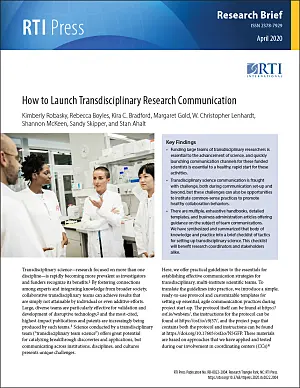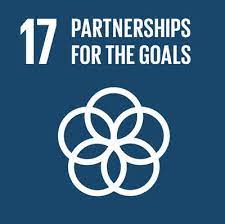Transdisciplinary science—research focused on more than one discipline—is rapidly becoming more prevalent as investigators and funders recognize its benefits (Hall, Vogel, & Croyle, 2019). By fostering connections among experts and integrating knowledge from broader society, collaborative transdisciplinary teams can achieve results that are simply not attainable by individual or even additive efforts. Large, diverse teams are particularly effective for validation and development of disruptive technology (Wu et al., 2019), and the most-cited, highest-impact publications and patents are increasingly being produced by such teams (Wuchty et al., 2007). Science conducted by a transdisciplinary team (“transdisciplinary team science”) offers great potential for catalyzing breakthrough discoveries and applications, but communicating across institutions, disciplines, and cultures presents unique challenges.
Key Findings
Funding large teams of transdisciplinary researchers is essential to the advancement of science, and quickly launching communication channels for these funded scientists is essential to a healthy, rapid start for these activities.
Transdisciplinary science communication is fraught with challenge, both during communication set-up and beyond, but these challenges can also be opportunities to institute common-sense practices to promote healthy collaboration behaviors.
There are multiple, exhaustive handbooks, detailed templates, and business administration articles offering guidance on the subject of team communications. We have synthesized and summarized that body of knowledge and practice into a brief checklist of tactics for setting up transdisciplinary science. This checklist will benefit research coordinators and stakeholders alike.
Here, we offer practical guidelines to the essentials for establishing effective communication strategies for transdisciplinary, multi-institute scientific teams. To translate the guidelines into practice, we introduce a simple, ready-to-use protocol and customizable templates for setting up essential, agile communication practices during project start-up. The protocol itself can be found at https://osf.io/wnb4m/, the instructions for the protocol can be found at https://osf.io/c9j37/, and the project page that contains both the protocol and instructions can be found at https://doi.org/10.17605/osf.io/N5GFP. These materials are based on approaches that we have applied and tested during our involvement in coordinating centers (CCs) (Rolland, 2019) and management for projects such as the Biomedical Data Translator (Biomedical Data Translator Consortium, 2019); Data Storage, Toolspace, Access, and analytics for biG-data Empowerment (DataSTAGE, http://bit.ly/2OVC9Ei); the Human BioMolecular Atlas Program (HuBMAP, https://commonfund.nih.gov/hubmap); and citizen science initiatives (http://eu-citizen.science/) (see Table 1).
Table 1.
44012Initiatives that informed the protocol
Communication Is Key
The science of team science is a rapidly emerging interdisciplinary field (Börner et al., 2010; Stokols et al., 2008) that empirically examines the underlying processes of team science and the circumstances that facilitate or hinder its effectiveness (Cooke & Hilton, 2015; Kozlowski & Bell, 2019; Mâsse et al., 2008). Successful team science is built on the foundations of collaboration, communication, and trust (Bennett et al., 2018; Fiore et al., 2015; Hall, Vogel, & Crowston, 2019; Southwell et al., 2019).
In addition to the practicalities of organizing a project and conducting research (Development of a Simplified Consortium Agreement. DESCA 2020 Model Consortium Agreement, 2020; Hall, Vogel, & Crowston, 2019; Vogel et al., 2013), establishing these foundations requires an appreciation for the role of norms and hidden biases related to power, prestige, rewards, and collegiality. Specifically, each collaborators’ ability to effectively share and implement ideas is crucial, but confounded by multiple, possibly unrecognized factors. For example, although the Internet facilitates remote interaction (Olson & Olson, 2013), computer-mediated collaboration is not as effective as collaboration in physically shared environments (Gibson & Gibbs, 2006; Kraut et al., 2002; Serrat, 2017). Multi-institutional teams face greater communication challenges and higher coordination costs than smaller, single-institution teams (Cummings & Kiesler, 2007). Transdisciplinary science team members may have a range of native languages and differing levels of mastery of the team’s common language. Cultures of people and places also play a role, influencing team members’ approaches to disagreement and attitudes toward hierarchy, responsibility, and autonomy. The many challenges to team transdisciplinary research (Strober, 2006) can result in delayed, misinterpreted, or nonexistent communication and impede discovery, trust, productivity, consensus, and division of labor.
In light of these challenges, it is crucial to nurture a culture of collaboration and a healthy communication climate during project start-up. This requires effective strategies and tools to support burgeoning collaborations and emerging communication channels.
Methods for Communicating Effectively
In contrast to teams in the business world, transdisciplinary science team leaders often do not have the option of managed growth, authoritative systems of governance, and explicit collaboration incentives. Typically funded by public grants, major scientific collaborations are often initialized with a large team of contributors and with loosely defined governance. Contributors may or may not have extant trust relationships or aligned motivations and goals; some may even have pre-established competitive relationships. Table 2 summarizes some key challenges of team science efforts, the opportunities arising from those challenges, and good practices for making the most of those opportunities. Team members may be faced with any of these key challenges at any stage.
Table 2.
44013Overcoming Common Team Science Challenges
| Challenge | Opportunities | Practices |
| Non-authoritative cross-team governance leading to lack of coherent framing of the problem (Brandt et al., 2013) and undefined task dependencies (Cooke & Hilton, 2015) | Crowd-sourced definition of the problem statement can bring the benefit of many minds | Anticipate the emergence and evolution of problems and goals as the project progresses, requiring agile problem-solving. Encourage teams to establish “SMART” goals: Specific, Measurable, Actionable, Realistic and Time-specific (Smith & Taylor, 2004) and identify task dependencies between sub-teams |
| Volunteered contributions from highly motivated scientists can result in exceptional intellectual merit | Provide an environment to allow self-assembly of diverse (age, gender, race, expertise) (Gomez & Bernet, 2019), cross-functional, well-performing, collaborative sub-teams | |
| Urgent needs for communication tools to define research and knowledge integration (Cooke & Hilton, 2015) and production processes (Brandt et al., 2013) in a context with little room for managed growth (e.g., teams are often assembled and already at their optimal size on the first funded day of the project) | Rapid implementation of a viable communication platform can facilitate open conversations to quickly establish trust and nurture collaboration | Prioritize the establishment of feedback channels that can critique the communication platform’s functionality, accommodating multiple sources and formats for feedback (Buckingham & Goodall, 2019) |
| Staff the feedback channels with a combination of humans and technology to allow automated, parallel processing of feedback on the communication platform as it evolves | ||
| Quickly address varying levels of familiarity with the chosen tool biases, accommodating individual preferences wherever possible (“individuals and interactions over processes and tools”) (Beck et al., 2001) | ||
| Empower the community to engage in the feedback pipeline at any step of the communication platform implementation | ||
| Aim to release the first version of the communication platform as a minimal viable product rather than as a complete solution | ||
| Consider intentionally reducing the number of communication channels to prevent miscommunication and reduce burden required to stay active on all platforms | ||
| Optimize communication platform release cycles for shortest possible duration | ||
| Keep current all resources on the communication platform (e.g., documents and calendar) | ||
| Establish practices for how to use which communication channels when, and why, especially with respect to where important communication happens; for example, engender “fear of missing out” to encourage the establishment of good tool-usage habits from the outset | ||
| Goal misalignment (Cooke & Hilton, 2015) due to fluctuating organization; multiple locations, languages, and working styles (e.g., formal/hierarchical vs. entrepreneurial/lateral); and lack of collaboration incentives (Cooke & Hilton, 2015) | Team diversity can result in innovative solutions from the cross-pollination of ideas (Rock & Grant, 2016) | Promote transparency to engender trust and the open sharing of ideas; e.g., do leave out budgetary/administrative content, as appropriate, but do not hold invitation-only meetings, which can work at odds with establishing an inclusive culture |
| Create a code of conduct that embraces time zone and language differences as well as cultural idiosyncrasies; for example, establish permission to speak bluntly where subtleties may be harder to communicate in a second language | ||
| Design onboarding and training procedures, including the creation of a team glossary, to establish common technical language, culture, and practices | ||
| Provide collaboration incentives, such as recognizing and encouraging open-ended “collaboration projects” | ||
| Facilitate opportunities for live “meet and greet” and cross-team work-product events (hackathons, workshops, other team-building exercises) to explicitly address team differences and create insights on the team’s unique collaboration culture |
Note: Practices are based on the authors’ experience leading or contributing to communication strategies for transdisciplinary science teams.
In our experience, successful processes for transdisciplinary team communication generally move in an iterative fashion through four stages: (1) defining goals (2), recognizing team dynamics (3), establishing communication strategies, and (4) monitoring and improving practices. These stages are detailed in the sections that follow.
Define Goals
Establishing and communicating the vision and goals of the project is essential to successful, on-target outcomes. Developing team and sub-team charters with objectives, deliverables, milestones, roles, responsibilities, and timelines solidifies the vision and clarifies the goals. Recognizing cross-team milestone dependencies and critical paths is an important starting place for overcoming the challenges of transdisciplinary team science. One useful technique is translating the team’s objectives into “SMART” goals—goals that are Specific, Measurable, Actionable, Realistic, and Time-specific (Smith & Taylor, 2004). Although each team science effort brings unique SMART goals, all teams aim to optimize their production of scientific output. This hinges upon their ability to promote unobstructed, efficient communication and collaboration.
Recognize Team Dynamics
Team dynamics strongly influence productivity and output. A common theory in group dynamics is that team development moves through four stages: forming, storming, norming, and performing (Bennett & Gadlin, 2012; Tuckman, 1965). In our experience, these stages can provide useful context to inform approaches to establishing effective team communication.
The first phase, team formation, should be agile, allowing for fluidity in team membership, leadership, and strategies to the extent possible within the agreed-upon scheme of work and division of tasks. During this phase, communicating the beliefs and values of the team as they relate to the common goal is crucial, as is encouraging members to feel safe in exposing vulnerability to establish trust (Coyle, 2018). Trust is also central to the storming phase, in which team members establish their working relationships and processes. “Over-communicating” can be useful at this stage: collaborators should continually provide and receive honest, positive feedback, explain why processes exist, and confirm understanding.
By the “norming” phase, the team will have settled into a shared language for the project, with a shared glossary for consistent understanding of key terms. At this point, the responsibility for maintaining team strategies and processes can be handed off to a sustaining team. Maintaining focus on the adopted strategies (“staying the course”) helps the team move from storming to norming and performing more quickly. Finally, as the team moves into a performance mode, the sustaining team monitors progress and tweaks processes as the project grows and the team’s needs change. A final stage—adjourning—should also be anticipated throughout the project and when transferring deliverables to outside entities (Tuckman & Jensen, 1977).
Although it is ideal to establish communication strategies before the team begins work, this is not always feasible. In many cases, it is necessary to stay agile in responding to complex and sometimes competing needs as the team begins work and evolves over time.
Establish Strategies
Generalizable tactics that facilitate effective team science communication include identifying stakeholders, establishing a communication plan, setting up communication infrastructure, responding to feedback and requests, and adhering to “findable, accessible, interoperable, reusable” (FAIR) data principles (Wilkinson et al., 2016) for the project and communication artifacts.
Stakeholder identification is a critical early activity in any project management exercise (Rose, 2013). In addition to team members, stakeholders may include funders (e.g., grant-making agencies, organizations, or venture capitalists; Congress; consumers), facilitators (e.g., software developers, working groups, collaboration facilitators), and end users, among others.
Next, it is vital to establish a plan outlining the team’s strategies for internal communication. This plan should describe the target audiences for communication activities; outline the frequency and channels for various types of communication; identify deliverables such as reports or notes; and specify who “owns” the communication and deliverables. A communication plan could also set parameters for meetings, calls, emails, scheduling, the creation and distribution of communication products, and the use of various tools in the communication platform, both within the team and when communicating with other stakeholders.
A centralized communication platform is one useful way to integrate a team’s internal communication processes. Shared technologies, such as a common website, intranet, or database, have been shown to improve the collaborative activities of a research team (Cummings & Kiesler, 2007). However, these technologies are valuable only if they actually improve the frequency and quality of communication. A common approach is to build a central communication platform that consolidates shared tools in an accessible and adaptable way. When selecting tools to include in the platform, it is important to identify potential barriers to adoption, such as complexity and steep learning curves, and to try to minimize them. Practices for using these tools should be outlined in the communication plan. It is important to empower users to drive decisions on the platform tools and features, emphasizing “individuals and interactions over processes and tools” (Beck et al., 2001).
The ability to receive and respond to stakeholder feedback on the communications strategy and platform is crucial to fostering healthy collaborations. Approaches to soliciting, receiving, and making feedback seem “normal” have been the subject of many business environment analyses (Batista, 2014). These analyses, along with our own experience, underscore the need to encourage feedback in all formats, be responsive, avoid alienating feedback providers, and maintain communication with feedback providers throughout the process of identifying and implementing changes. Feedback providers’ names should be mapped to an actionable change request so they can be contacted with any questions and given updates on the status and timing of changes to address the feedback.
Finally, it is valuable to apply the FAIR data principles to the communication platform. For example, using communication technology standards and version tracking; announcing updates; broadly documenting processes; and publishing cross-linked, citable documentation can ensure communication artifacts are FAIR (Wilkinson et al., 2016) throughout the project and beyond.
Monitor and Improve
Team dynamics and communication requirements evolve as a project progresses and the team grows, shrinks, or matures. In addition to mechanisms for monitoring and control of communication strategy and platform, agility and responsiveness are required to allow for continual improvement. General activities to support monitoring and improvement include the following:
Establishing processes for documenting communication tools and updates and training users
Defining processes for soliciting, triaging, and responding to feedback
Surveying contributors for a baseline on team health (Mâsse et al., 2008)
Designing an issue tracking platform to track feedback and important decisions, if project complexity warrants the extra effort
Checking in with stakeholders regularly to ensure communication frequency, methods, and target audiences remain valid
Teams should build in enough flexibility to switch out communication platform tools as needed in response to feedback; embrace designs and processes that allow for iterative cycles of improvement; and, when possible, avoid designs that require early vendor lock-in.
Future Transdisciplinary Research Needs: A Protocol
With a thorough understanding of the landscape, goals, strategies, tactics, and monitoring needs relevant to supporting effective communication, a team is well-positioned to establish a healthy communication culture for a new transdisciplinary team science initiative. To translate these guidelines into practical tools, we combined our collective experience in launching large transdisciplinary science initiatives (see Table 1) to create a concise, specific protocol of only the bare essentials for launching communication (http://OSF.IO/N5GFP, https://osf.io/wnb4m/).
Collectively, our team science efforts faced all of the common communication challenges (see Table 2), and we carefully devised (Gough & Hamrell, 2010) a protocol (“CF-1: Transdisciplinary Research Communications Set-up”) that generalizes the methods we found to be most successful in our practice. The protocol is intended as a starting point to adjust as appropriate to meet the needs of each initiative and its scientific goals, team membership, funding parameters, and legal requirements. In contrast to the perspective and context offered here, the CF-1 protocol specifies step-by-step instructions for the practitioner. Team leaders are encouraged to freely download and customize the protocol, leaving only the citation intact. We invite other practitioners to join us in growing this repository with customizable and essential protocols that cover other stages of the project lifecycle.
As the science of team science evolves, we welcome the community to update the CF-1 protocol, contribute new protocols, and log requests to the main GitHub repository (https://github.com/ResearchSoftwareInstitute/TRTemplates). For the latest version of the published protocol, please visit https://osf.io/wnb4m/.


